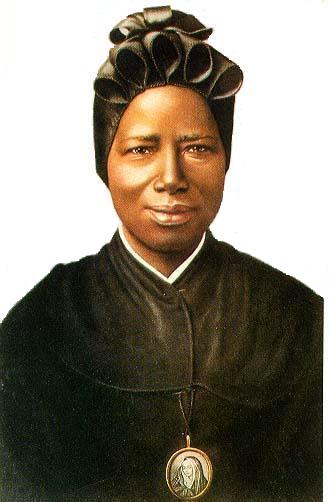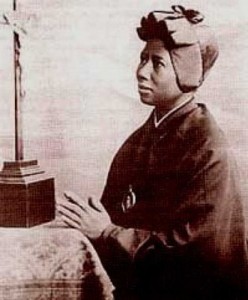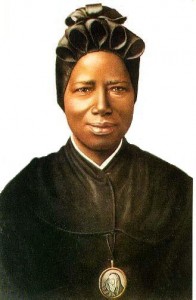
GOOD MORNING PRAGOBOTS!
We continue our series on Black Saints and Popes…
SAINT JOSEPHINE BAKHITA
The Modern Saint
Josephine Margaret Bakhita, F.D.C.C., was a Sudanese-born former slave who became a Canossian Religious Sister in Italy, living and working there for 45 years. In 2000 she was declared a saint by the Roman Catholic Church.
Early life
She was born in about 1869 in the western Sudanese region of Darfur; in the village of Olgossa, west of Nyala and close to Mount Agilerei.[1] She belonged to the prestigious Daju people;[2][3] her well respected and reasonably prosperous father was brother of the village chief. She was surrounded by a loving family of three brothers and three sisters; as she says in her autobiography: “I lived a very happy and carefree life, without knowing what suffering”.[4]
Sometime between the age of seven to nine, probably in February 1877, she was kidnapped by Arab slave traders, who already had kidnapped her elder sister two years earlier. She was cruelly forced to walk barefoot about 960 kilometers (600 mi) to El Obeid and was already sold and bought twice before she arrived there. Over the course of twelve years (1877–1889) she was resold again three more times and then given away. It is said that the trauma of her abduction caused her to forget her own name; she took one given to her by the slavers, bakhita, Arabic for lucky.[5][6] She was also forcibly converted to Islam.[7]
Life as a slave
In El Obeid, Bakhita was bought by a very rich Arab merchant who employed her as a maid in service to his two daughters. They liked her and treated her well. But after offending one of her owner’s sons, possibly for breaking a vase, the son lashed and kicked her so severely that she spent more than a month unable to move from her straw bed. Her fourth owner was a Turkish general and she had to serve his mother-in-law and his wife who both were very cruel to all their slaves. Bakhita says: “During all the years I stayed in that house, I do not recall a day, that passed without some wound or other. When a wound from the whip began to heal, other blows would pour down on me”.[8]
She says that the most terrifying of all her memories there, was when she (in common with other slaves) was marked by a process resembling both scarification and tattooing.[9] As her mistress was watching her with a whip in her hand, a dish of white flour, a dish of salt and a razor were brought by a woman. She used the flour to draw patterns on her skin and then she cut deeply along the lines before filling the wounds with salt to ensure permanent scarring. A total of 114 intricate patterns were cut into her breasts, belly, and into her right arm.[10][11]
Conversion and freedom
By the end of 1882 El Obeid came under the threat of an attack of Mahdist revolutionaries.[12] The Turkish general began making preparations to return to his homeland. He sold all his slaves but selected ten of them to be sold later, on his way through Khartoum. There in 1883 Bakhita was bought by the Italian Vice Consul Callisto Legnani, who was a very kind man. For the first time since her captivity she was able to enjoy some peace and tranquillity. Two years later, when Legnani himself had to return to Italy, Bakhita begged to go with him. By the end of 1884 they left already besieged Khartoum, on a risky 650-kilometer (400 mi) trip on camel back, to Suakin, which then was the largest port of Sudan. In March 1885 they left Suakin for Italy and in April, at the Italian port of Genoa, they were met by the wife of a friend, Augusto Michieli, who had escaped from Khartoum with them. Callisto Legnani gave Bakhita as a present to Signora Maria Turina Michieli, and her new masters took her to their family villa at Zianigo, near Mirano Veneto, about 25 km (16 mi) west of Venice.[9] She lived there for three years and became nanny to the Michieli’s daughter Alice, known as Mimmina, born in February 1886. With her new family Bakhita even spent about nine months in Sudan again.
Suakin had also been besieged but remained in Anglo-Egyptian hands. Augusto Michieli acquired there a large hotel, decided to sell his entire property in Italy and to move his family to Sudan permanently. The selling of his house and lands took much longer than expected and by the end of 1888 Turina had to see her husband before the sale was complete. Since the villa in Zianigo was already sold, Bakhita and Mimmina needed a temporary place to stay. At the advice of their business agent Illuminato Cecchini, on 29 November 1888, Signora Turina Michieli left them in the custody of the Canossian Sisters in Venice. But when she returned to take them both to Suakin, Bakhita firmly refused to leave. For a full three days Mrs. Michieli tried to force the issue, but the superior of the institute for baptismal candidates (Catechumenate) buy viagra connect online usa that Bakhita had attended, complained to the authorities. On 29 November 1889 an Italian court ruled that, because Sudan had outlawed slavery before Bakhita’s birth and because in any case Italian law did not recognize slavery, Bakhita had never legally been a slave.[13] Bakhita had now reached the age of maturity; for the first time in her life she found herself in control of her own destiny. And she chose to remain with the Canossians.[14]
Canossian Sister
On 9 January 1890 Bakhita was baptised with the names of Josephine Margaret and Fortunata (which is the Latin translation for the Arabic Bakhita). On the same day she was also confirmed and received Holy Communion from Archbishop Giuseppe Sarto, the Cardinal Patriarch of Venice, the future Pope Pius X, himself.[15] On 7 December 1893 she entered the novitiate of the Canossian Sisters and on 8 December 1896 she took her vows, welcomed by Cardinal Sarto. In 1902 she was assigned to the Canossian convent at Schio, in the northern Italian province of Vicenza, where she spent the rest of her life. Her only extended time away was between 1935 and 1939, when she stayed at the Missionary Novitiate in Vimercate (Milan); mostly visiting other Canossian communities in Italy, talking about her experiences and helping to prepare young sisters for work in Africa.[15] A strong missionary drive animated her throughout her entire life – “her mind was always on God, and her heart in Africa”.[16]
the Latin translation for the Arabic Bakhita). On the same day she was also confirmed and received Holy Communion from Archbishop Giuseppe Sarto, the Cardinal Patriarch of Venice, the future Pope Pius X, himself.[15] On 7 December 1893 she entered the novitiate of the Canossian Sisters and on 8 December 1896 she took her vows, welcomed by Cardinal Sarto. In 1902 she was assigned to the Canossian convent at Schio, in the northern Italian province of Vicenza, where she spent the rest of her life. Her only extended time away was between 1935 and 1939, when she stayed at the Missionary Novitiate in Vimercate (Milan); mostly visiting other Canossian communities in Italy, talking about her experiences and helping to prepare young sisters for work in Africa.[15] A strong missionary drive animated her throughout her entire life – “her mind was always on God, and her heart in Africa”.[16]
During her 42 years in Schio, Bakhita was employed as the cook, sacristan and portress (door keeper) and was in frequent contact with the local community. Her gentleness, calming voice, and ever-present smile became well known and Vicenzans still refer to her as Sor Moretta (“little brown sister”) or Madre Moretta (“black mother”). Her special charisma and reputation for sanctity were noticed by her order; the first publication of her story (Storia Meravigliosa by Ida Zanolini) in 1931, made her famous throughout Italy.[2][17] During the Second World War (1939–1945) she shared the fears and hopes of the town people, who considered her a saint and felt protected by her mere presence. Not quite in vain as the bombs did not spare Schio, but the war passed without one single casualty.
Her last years were marked by pain and sickness. She used a wheelchair, but she retained her cheerfulness, and if asked how she was, she would always smile and answer “as the Master desires”. In the extremity of her last hours her mind was driven back to the years of her slavery and she cried out “The chains are too tight, loosen them a little, please!”. After a while she came round again. Someone asked her: “How are you? Today is Saturday”. “Yes, I am so happy: Our Lady… Our Lady!”. These were her last audible words.[18]
Bakhita died at 8:10 PM on 8 February 1947. For three days her body lay on display while thousands of people arrived to pay their respects.
Legacy and canonization
A young student once asked Bakhita: “What would you do, if you were to meet your captors?” Without hesitation she responded: “If I were to meet those who kidnapped me, and even those who tortured me, I would kneel and kiss their hands. For, if these things had not happened, I would not have been a Christian and a religious today”.[19]
The petitions for her canonization began immediately, and the process officially commenced by Pope John XXIII in 1959, only twelve years after her death. On 1 December 1978, Pope John Paul II declared Josephine Venerabilis, the first step towards canonization. On 17 May 1992, she was declared Blessed and given February 8 as her feast day. On 1 October 2000, she was canonized and became Saint Josephine Bakhita. She is venerated as a modern African saint, and as a statement against the brutal history of slavery. She has been adopted as the only patron saint of Sudan.
Bakhita’s legacy is that transformation is possible through suffering. Her story of deliverance from physical slavery also symbolizes all those who find meaning and inspiration in her life for their own deliverance from spiritual slavery.[20] On a larger scale, however, Bakhita’s story of a slave who was forced to convert to Islam and later chose Christianity represents a conflict between Christianity and Islam. In May 1992 news of her beatification was banned by Khartoum which Pope John Paul II then personally visited only nine months later.[7] On 10 February 1993, facing all risks, surrounded by an immense crowd in the huge Green Square of the capital of Sudan, he solemnly honoured Bakhita on her own soil. “Rejoice, all of Africa! Bakhita has come back to you. The daughter of Sudan sold into slavery as a living piece of merchandise and yet still free. Free with the freedom of the saints.” [21]
Pope Benedict XVI, on 30 November 2007, in the beginning of his second encyclical letter Spe Salvi (In Hope We Were Saved), relates her entire life story as an outstanding example of the Christian hope. Sadly, the suffering of her people in Sudan continues.[22][23]

